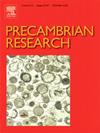Paleoproterozoic granite in the Khondalite Belt, northern margin of the North China Craton: Response to the assembly of the Columbia supercontinent
IF 3.2
2区 地球科学
Q2 GEOSCIENCES, MULTIDISCIPLINARY
引用次数: 0
Abstract
Metapelitic gneiss (sillimanite–biotite–garnet gneiss) and S-type granites have been identified in the Khondalite Belt (KB), located in the northeastern margin of the North China Craton (NCC), which has traditionally been considered closely related to the São Francisco–Congo Craton (SFCC). Zircon U–Pb–Hf isotopic experiments on these rocks revealed two distinct late Paleoproterozoic age groups: 2.00–1.95 and 1.93–1.90 Ga. The 2.00–1.95 Ga magmatic zircon cores displayed εHf(t) values ranging from −1.94 to +7.48, with two-stage Hf model ages between 2.28 and 2.71 Ga. The 1.93–1.90 Ga ages obtained from the S-type granites were interpreted as late Paleoproterozoic anatectic magmatism, which coincides with the metamorphism and anatexis ages derived from the metapelitic gneisses. The 1.93–1.90 Ga anatectic zircon rims exhibited significantly lower 176Lu/177Hf and 176Hf/177Hf values compared to the inherited magmatic zircon cores, indicating that the Lu–Hf isotope compositions were reset during anatexis. A comparative study suggests that the similarities between the khondalite rocks (or granitic rocks in KB) of the NCC and SFCC, such as related mineral paragenesis and reactions, provenance, tectonic setting, depositional age, nearby P–T conditions, and metamorphism age, indicate a potential genetic correlation of these rocks. Therefore, the late Paleoproterozoic metamorphic and anatectic events align with global orogenic events recorded in several continental fragments, suggesting a connection to the Columbia supercontinent.
华北克拉通北缘孔雀岩带古元古代花岗岩:对哥伦比亚超大陆组装的响应
在华北克拉通(NCC)东北缘的孔雀岩带(KB)中发现了变质长岩片麻岩(硅线-黑云母-石榴石片麻岩)和s型花岗岩,传统上认为孔雀岩带与旧金山-刚果克拉通(SFCC)密切相关。锆石U-Pb-Hf同位素实验揭示了晚古元古代2.00 ~ 1.95 Ga和1.93 ~ 1.90 Ga两个不同的年龄群。2.00 ~ 1.95 Ga岩浆锆石的εHf(t)值在- 1.94 ~ +7.48之间,两段Hf模式年龄在2.28 ~ 2.71 Ga之间。s型花岗岩的1.93 ~ 1.90 Ga年龄解释为晚古元古代的深熔岩浆作用,与深熔变质片麻岩的变质和深熔作用年龄一致。1.93 ~ 1.90 Ga深熔锆石边缘的176Lu/177Hf和176Hf/177Hf值明显低于继承的岩浆锆石岩心,说明深熔锆石的Lu-Hf同位素组成在深熔过程中被重置。对比研究表明,北陆和南陆的孔雀岩(或称花岗质岩)在相关矿物共生反应、物源、构造环境、沉积时代、附近P-T条件、变质作用年龄等方面具有相似性,表明它们具有潜在的成因相关性。因此,晚古元古代的变质和分离事件与若干大陆碎片记录的全球造山事件一致,表明与哥伦比亚超大陆有关。
本文章由计算机程序翻译,如有差异,请以英文原文为准。
求助全文
约1分钟内获得全文
求助全文
来源期刊

Precambrian Research
地学-地球科学综合
CiteScore
7.20
自引率
28.90%
发文量
325
审稿时长
12 months
期刊介绍:
Precambrian Research publishes studies on all aspects of the early stages of the composition, structure and evolution of the Earth and its planetary neighbours. With a focus on process-oriented and comparative studies, it covers, but is not restricted to, subjects such as:
(1) Chemical, biological, biochemical and cosmochemical evolution; the origin of life; the evolution of the oceans and atmosphere; the early fossil record; palaeobiology;
(2) Geochronology and isotope and elemental geochemistry;
(3) Precambrian mineral deposits;
(4) Geophysical aspects of the early Earth and Precambrian terrains;
(5) Nature, formation and evolution of the Precambrian lithosphere and mantle including magmatic, depositional, metamorphic and tectonic processes.
In addition, the editors particularly welcome integrated process-oriented studies that involve a combination of the above fields and comparative studies that demonstrate the effect of Precambrian evolution on Phanerozoic earth system processes.
Regional and localised studies of Precambrian phenomena are considered appropriate only when the detail and quality allow illustration of a wider process, or when significant gaps in basic knowledge of a particular area can be filled.
 求助内容:
求助内容: 应助结果提醒方式:
应助结果提醒方式:


